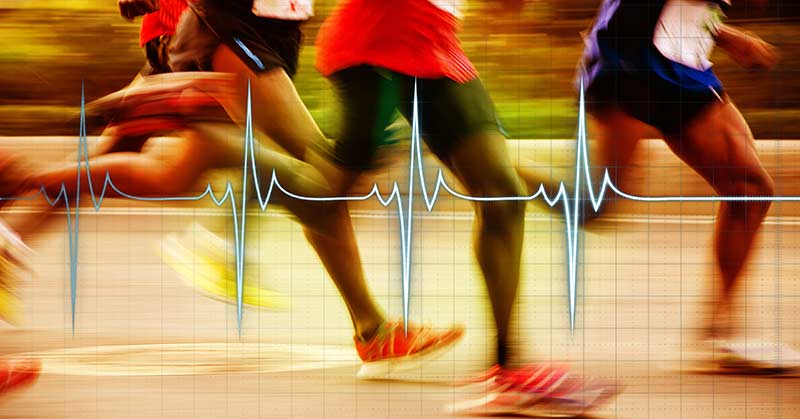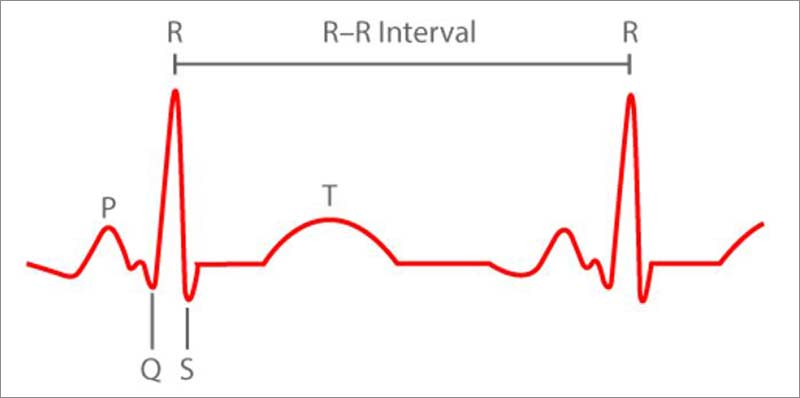[mashshare]

Heart rate variability (HRV) is a relatively new tool for monitoring cardiac stress in an individual, often for athletic purposes, which is a direct reflection of the collective forms of stress that the body is exposed to in a given environment. This includes training stress, mental stress, hydration levels, emotional stress, anxiety, fatigue, and more.
HRV measures the heart’s contractile variation from beat to beat by evaluating the consistency between R waves (R-R intervals), as seen on an electrocardiogram (ECG) reading:

Typically, the less stressed and fatigued the body is, the more variable the time interval between heartbeats. This interval is highly specific to an individual and can vary according to the individual’s anatomy (size of left ventricle), prior fitness background, hormonal status, exercise modality, age, gender, mood, and economic efficiency. External factors such as body position, temperature and humidity, altitude, and drugs or stimulants can also impact daily stress on the autonomic system.
How Is HRV Measured?
You don’t need an ECG machine or other fancy equipment to extract this data. A heart rate monitor and the HRV software will do—many programs are now well adapted in app form, with measurements taken in the comfort of the home by utilizing a heart rate monitor and smartphone for one to three minutes.
HRV can now be measured using a heart rate monitor and smartphone app in the comfort of your home. Share on XHigh-frequency power (HFP) is a sub-marker for changes in heart rate variability, specifically pertaining to cardiac parasympathetic activity (Kingsley & Figueroa, 2016). Heart rate recovery after exercise is largely influenced by the parasympathetic nervous system’s reactivation and sympathetic deactivation as the body gradually returns to a resting state. Changes in HRV in response to training can provide insight into the way the cardiac autonomic system is responding to the exercise. Longer heart rate recovery times will yield lower HRV readings, indicating the need for more rest. Conversely, increases in HFP and HRV have been linked to improved fitness levels. Different modalities of training will provide different responses in cardiac recovery, and therefore should be treated individually with respect to HRV response and training adaptation.
How Does Training Stress Affect HRV?
A range of research studies have shown that high-intensity endurance training improves (increases) heart rate variability. Nummela et al. (2016) performed a study where, after a four-week base training period, participants were split into either an experimental training group with three added high-intensity sessions per week, or a control group with no changes in training, for a subsequent four-week period. This study showed that the high-intensity group improved their VO2 max, decreased their nocturnal heart rate, and increased their nocturnal high frequency power (HFP) after the four-week cycle.
A lower resting heart rate and higher HFP, as found in this study, are both related to higher levels of endurance performance. This study is also an example of how variation in intensity versus constant-load aerobic exercise is necessary to exhibit changes in aerobic capacity, as observed by the lack of changes in the constant-load control group. High-intensity training is thought to improve both the central and peripheral components of VO2 max, whereas constant-load training mainly affects oxygen extraction in the periphery.
The effect of endurance exercise on HRV is clearly beneficial to aerobic fitness; however, resistance training does not elicit the same type of adaptation. While we are looking to see an increase in the parasympathetic activity post-exercise, acute resistance exercise appears to have the opposite effect, regardless of age (Kingsley & Figueroa, 2016).
A supporting study by Vrachimis et al. (2016) suggested that circuit training in the form of bodyweight exercises was not a sufficient form of exercise to impact resting HRV in healthy, untrained adults. In this study, other factors improved during the six-week training period, including decreased diastolic blood pressure and increased lean body mass, VO2 max, and other strength measures. This particular modality of training may reduce the risk of developing cardiovascular disease, but is an insufficient stimulus to improve HRV and the body’s autonomic response to training.
HRV as a Predictor of Overtraining and Adaptation
You can draw a fine line between overtraining and adaptation: to maximize progress during a particular training cycle, athletes usually hover on the brink between the two. Three factors that can individually or collectively lead an athlete into an overtrained state are: an overload in volume and/or intensity, an uncontrollable magnitude in load, and a lack of recovery time between loads.
In non-contact sports, the load can often be directly controlled and executed. In contact sports, however, it is much more difficult to control the intensity placed on athletes during each training session (Morales et al., 2014). In a 2014 study of judo athletes by Morales et al., they compared a randomized high-training load group (daily judo sessions plus additional conditioning and strength sessions twice each week) to a moderate-training load group (only three judo sessions per week). Participants in the high-training load group showed a significant imbalance of the autonomic nervous system, as indicated by lower HRV scores. In addition, this group demonstrated a decrease in strength parameters, higher levels of stress markers, and a lower perception of recovery. The predominance of sympathetic activity in these athletes indicates the presence of lingering physical and/or mental stress, and thus, incomplete recovery from training.
A study by Vesterinen, Hakkinen et al. (2016) aimed to predict individual adaptation to either high-volume or high-intensity endurance training. An eight-week base period standardized for all participants was followed by an eight-week experimental period with participants randomly placed into one of two groups. The high-volume training group increased their volume by 30-50%, while the training intensity remained the same; the high-intensity group replaced three low-intensity sessions per week with three moderate- or high-intensity sessions performed at heart rates above the lactate threshold, with volume remaining the same. The participants in this study were recreational endurance runners with a solid fitness base.
The results of the study indicate that, in individuals with a well-developed fitness level, low-intensity high-volume training many not provide sufficient stimulus to disturb the autonomic homeostasis in order to initiate desirable training adaptation. Furthermore, the study demonstrated that individuals with a higher vagal activity (HFP) have a more-adept capacity to cope with increased training intensity and load, leading to greater adaptation response. In addition, the study suggested that individuals with lower vagal activity and less training experience would respond with greater adaptation to the lower-intensity, higher-volume program.
The findings demonstrated by these two studies indicate that coaches can use autonomic response to training stress as a tool and marker for monitoring overtraining and adaptation. Individual athletes can respond very differently to the same stress, since many physiological, environmental, mental, and emotional factors are at play. Considering all these factors, coaches cannot assume that a particular training stress will elicit the same response across all athletes…and thus, HRV comes into play.
HRV as a Program Design Tool
One of the easiest and most direct ways to monitor this response is to include daily resting HRV measurements into the athlete’s schedule to ensure the programming is capitalizing on maximum adaptation and the avoidance of overtraining symptoms. Vesterinen, Nummela et al. (2016), mentioned that moderately fit men showed greater response in VO2 max, and healthy individuals showed improved endurance, when both groups were prescribed with high-intensity training sessions according to their HRV reading. The results of both groups were in comparison to a control group executing a predefined training program. The study authors suggested that women may need a differently tailored HRV-guided program than men, as they are often more susceptible to prolonged recovery, though the specific gender differences were not explored by this study.
A major advantage of HRV monitoring throughout training is to avoid the imbalance between training load and recovery, not to mention the fact that cardiac autonomic regulation is an important determinant of endurance training adaptation and performance. Coaches have a non-invasive, physiologic indicator of program efficacy right at their fingertips…all that you need is a heart rate monitor and an HRV software/app to make it happen.
Since you’re here…
…we have a small favor to ask. More people are reading SimpliFaster than ever, and each week we bring you compelling content from coaches, sport scientists, and physiotherapists who are devoted to building better athletes. Please take a moment to share the articles on social media, engage the authors with questions and comments below, and link to articles when appropriate if you have a blog or participate on forums of related topics. — SF
[mashshare]
References
- Kingsley, J. & Figueroa, A. (2016). “Acute and training effects of resistance exercise on heart rate variability.” Clinical Physiology & Functional Imaging Volume, 36(3), 179-187.
- Morales J., Alamo, J. M., García-Massó, X., Buscà, B., López, J. L., Serra-Añó, P., & González, L. M. (2014). “Use of heart rate variability in monitoring stress and recovery in judo athletes.” Journal of Strength & Conditioning Research, 28(7), 1896-1905.
- Nummela, A., Hynynen, E., Kaikkonen, P., & Rusko, H. (2016). “High-intensity endurance training increases nocturnal heart rate variability in sedentary participants.” Biology of Sport, 33(1), 7-13.
- Vesterinen, V., Hakkinen, K., Laine, T., Hynynen, E., Mikkola, J., & Nummela, A. (2016). “Predictors of individual adaptation to high-volume or high-intensity endurance training in recreational endurance runners.” Scandinavian Journal of Medicine and Science in Sports, 26, 885-93.
- Vesterinen, V., Nummela, A., Heikura, I., Laine, T., Hynynen, E., Botella, J., & Hakkinen, K. (2016). “Individual endurance training prescription with heart rate variability.” Medicine and Science in Sports and Exercise, 48(7), 1347-54.
- Vrachimis, A., Hadjicharalambous, M., & Tyler, C. (2016). “The effect of circuit training on resting heart rate variability, cardiovascular disease risk factors and physical fitness in health untrained adults.” Health, 8, 144-55.




